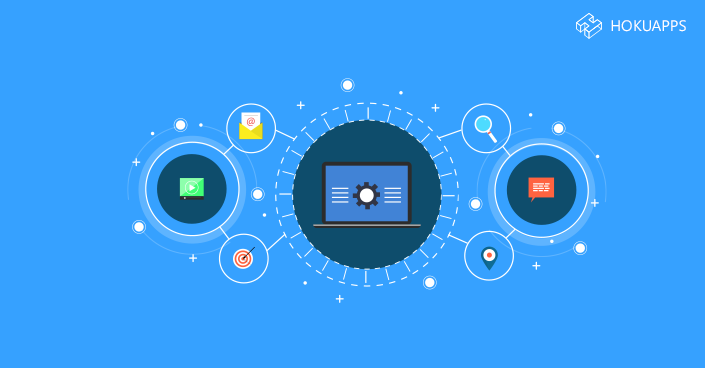- Products
- Solutions
- Services
- Resources
- Customer Success
- Company
- Sign In
- Contact Us

Digital Transformation enabler helping enterprises evolve by connecting technology
Take a look at upcoming webinars and special events
HokuApps news and media coverage
Be with the best. Solve real problems
Get in touch with our experts here
Explore our extensive collection of online resources here
Information and insight on transformation to the Digital Workplace
Quick Guides provide concise information on a variety of topics
Discover the essence of HokuApps’ products
Learn all about HokuApps’ cutting-edge enterprise mobility technology

iOS app development must identify and leverage the best practices and tools in the industry to create applications that can meet Apple’s stringent quality control parameters. These practices also serve to construct apps that contribute greater value to users’ experiences.
Given the centrality of iPhone Application Development in the software strategy of organizations, the quality of iOS apps being created is a non-negotiable feature. In particular, Apple ’s demanding focus on the quality of apps hosted on the App Store places immense pressure on developers and app development processes alike. To create apps that are consistent with high quality and optimal functionality, developers must implement a process that integrates a number of best practices.
Most applications are developed from a codebase that is in constant flux. It is always affected by the changing requirements. Debugging, merging and building an app require a set of code that can be continuously managed to achieve the desired outcome.
Traditional approaches to iOS/iPhone app development usually results in the emergence of a range of issues. Usually, the process entails developers to add changes to the codebase in an ongoing cycle, but only after those changes have been incorporated into the build of an app. Consequently, a time lag occurs, change to the code are added only after previous changes have been compiled into the app’s interface.
This methodology has a few common disadvantages:

Newer methods of iPhone Application development address the above-mentioned issues and more. It entails the use of practices and tools which aim to maintain apps in a consistently deployable state. This means that at any given moment, an app is up-to-date with the latest upgrades as designed and suggested by Apple.
Once engineers deliver the code and design, approval is given by quality assurance personnel and project managers, the code is immediately added to the app’s structure. There is no lag between modifications to the code and their implementation to the final prototype.
A major disadvantage of the traditional approach occurs when companies stick to release dates and then adhere to them even if the app is completely ready beforehand. This defeats the purpose of an iterative approach. If by chance users start exhibiting dissatisfaction about a certain major release, then it is harder for developers to know which particular features might be causing this dissatisfaction. An iterative system would allow developers to discontinue particular updates if they result in negative feedback.
This format of app development allows iOS app development to deploy apps to App Store with greater efficiency and improve overall quality simultaneously.
The iPhone Application development process begins with the intention to create an initial build which also exists ready for deployment. After this, developers keep adding code to a code repository such as GitHub. HokuApps maintains its own secure repository for this process. A continuous integration system similar to Jenkins then engages with the code on our repository. It enables automatic testing as the code is uploaded and constructs build in order to get the app to function in line with the new, changed sets of code.
This occurs in a cycle throughout the iPhone Application Development Service. Developers can keep establishing their own branches of code, make changes and then direct it back to the master branch where it is tested. This is repeated as often as necessary, and the app is always maintained with a build that has been tested and is ready for release.
This entails assigning specific profiles to builds which can be distributed for a variety of purposes. How a profile is signed dictates the way in which the code is utilized. These profiles are located on Apple’s developer portal. Each has an App ID. The nature of profiles can vary. For example:
This entails the creation of app builds that have been assigned to specific uses. Since the app stays in a constant deployment-ready state, every build is always guaranteed to be the latest version imbued with the most updated and recently tested code.

Software such as Jenkins implements this step, which basically refers to automating build management. Each time a developer adds new code to the repository, it is immediately tested to check for any errors as well as for perfect functionality.
The developer receives the test results, which states how the app has performed and if any issues are detected in the process. If fixes are necessary, they are made accordingly and immediately. Testing is done after each iteration, that is, after each change in the code. This continues until the app runs seamlessly, and then the code is added to the master codebase which generates the app’s build. This step ensures that the master code is not infected with erroneous code.
After being tested, builds are uploaded to some kind of continuous delivery service (such as Testflight or HockeyApp). This service acts as a portal which facilitates downloads of the build as required. It also prevents the kind of delivery lag.

This phase requires the incorporation of project management tools which manages the entire workflow, assigns work, tracks progress and lets developers offer comments for each revision they make to the code.
Usually when developers make a change and are merging it into the master codebase, the open pull requests on the code repository. Snapshots of the changes being made are captured, accompanied by developer’s comments. This keeps the entire developer team updated on how the code is morphing and evaluate it for possible issues or enact improvements. Consequently, it refines and optimized iPhone App Development with minimal effort.